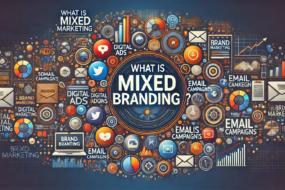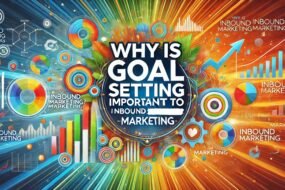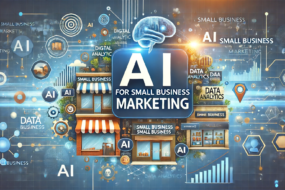
Embark on a journey into the realm of “What is Virtual Marketing?” as we unravel the intricacies of this dynamic and transformative landscape. In an era where businesses are navigating the digital domain with unprecedented vigor, understanding the nuances of virtual marketing has become paramount.
Join us as we delve into the key concepts, strategies, and innovations that define virtual marketing, exploring its impact on businesses, consumers, and the ever-evolving landscape of the online marketplace. From immersive technologies to data-driven insights, our blog aims to be your guide, providing comprehensive insights and illuminating the path through the exciting terrain of virtual marketing.
Let’s navigate this digital frontier together, unraveling the mysteries and uncovering virtual marketing opportunities for businesses in the contemporary world.
What Is Virtual Marketing?
Digital marketing, alternatively termed virtual or online Marketing, involves leveraging digital channels and technologies to endorse products, services, and brands to a target audience.
It involves a variety of strategies and techniques that harness the power of the internet, social media platforms, search engines, content marketing, and other digital tools to connect with and captivate customers.
Virtual marketing takes advantage of the widespread use of technology and the internet to establish connections between businesses and their target market more efficiently and cost-effectively than traditional marketing methods.
It enables companies to establish a footprint in the online domain, increase brand visibility, generate leads, drive website traffic, and convert potential customers into paying customers.
Some standard virtual marketing components and tactics include:
- Website Optimization: Optimizing a user-friendly website optimizing website for search engines (SEO) to improve its visibility in search results.
- Social Media Marketing: Leveraging social platforms like Facebook, Instagram, Twitter, LinkedIn, and YouTube to engage with users, build a following, and promote products or services.
- Content Marketing: Creating and sharing valuable and relevant content, such as blog posts, articles, videos, infographics, and podcasts, to attract and retain a target audience.
- Email Marketing: Sending subscribers targeted promotional emails or newsletters to nurture leads, build customer relationships, and drive sales.
- Search Engine Marketing (SEM): Using paid advertising campaigns on search engines like Google Ads to increase visibility and drive website traffic.
- Influencer Marketing: Collaborating with influential individuals on social media with a large following and credibility to promote products or services to their audience.
- Affiliate Marketing: Partner with affiliates who promote your products or services, promote products or services, and receive a commission for every successful sale or referral they generate.
- Online Advertising: Displaying ads on various digital platforms, such as banner ads, pop-ups, or video ads, to increase brand awareness and drive traffic.
- Mobile Marketing: Optimizing marketing efforts for mobile devices, including mobile-responsive websites, mobile apps, and targeted mobile ads.
- Data Analytics and Tracking: Utilizing tools utilize analytics to assess the efficiency of marketing campaigns, monitor and examine user behavior, and implement data-driven decisions for optimizing future marketing efforts.
Virtual Marketing Examples
Virtual marketing provides businesses with a wide range of opportunities to target specific audiences, track campaign performance, and adapt strategies based on real-time data.
It allows for personalized communication, precise targeting, and the ability to reach a global audience, rendering it a crucial element of contemporary marketing strategies.
Virtual marketing uses digital platforms and technologies to promote products, services, or brands. Here are some examples of virtual marketing strategies and tactics:
- Social Media Campaigns: Companies can leverage social media platforms like Facebook, Instagram, Twitter, and LinkedIn to create engaging content, run targeted ads, and interact with their audience. They can host virtual events, contests, and giveaways to generate brand awareness and attract potential customers.
- Influencer Marketing: Collaborating with influencers in a specific industry or niche can be a powerful virtual marketing strategy. Brands can partner with influencers with a large following and a relevant audience to promote their products or services via sponsored content, reviews, or endorsements.
- Virtual Reality (VR) and Augmented Reality (AR): VR and AR technologies allow businesses to create immersive customer experiences. For example, a furniture retailer can develop a virtual showroom where customers can visualize how various pieces of furniture might appear in their living spaces. AR can be employed to craft interactive product demonstrations or virtual try-on experiences for fashion and beauty brands.
- Webinars and Online Events: Hosting webinars and online events effectively educates and engages with target audiences. Companies can organize virtual conferences, workshops, or product launches, allowing participants to join from anywhere worldwide. This empowers businesses to access a broader audience and generate leads.
- Virtual Product Demonstrations: Companies can create virtual product demos using videos, 3D animations, or interactive platforms instead of traditional in-person demonstrations. This approach allows potential customers to explore and understand a product’s features and benefits without being physically present.
- Gamification involves incorporating game-like elements into marketing campaigns to increase engagement and customer participation. Virtual marketing can use gamification techniques such as contests, quizzes, challenges, and rewards to make the marketing experience more interactive and enjoyable.
- Virtual Assistants and Chatbots: Intelligent and virtual assistants can be incorporated into websites or messaging platforms to deliver real-time customer support, address frequently asked questions, and assist with purchase decisions. These automated systems can enhance the overall customer experience and improve engagement.
- Virtual Tours and 360-Degree Videos: Businesses in the travel, real estate, or hospitality industries can offer virtual tours of their properties or destinations. Using 360-degree videos or virtual reality, potential customers can explore hotels, vacation rentals, tourist attractions, or real estate listings from their homes.
These are just a few examples of how virtual marketing can be implemented to reach and engage with customers in today’s digital landscape. The key is to leverage technology to create distinctive and unforgettable experiences that align with the target audience’s preferences and behaviors.
Advantages and disadvantages of virtual marketing
Source : youtube.com
Advantages of Virtual Marketing:
- Global Reach: Virtual marketing allows businesses to reach a broad global audience without the constraints of physical distance. Companies can engage with potential customers across different countries and continents through various online platforms and tools, expanding their market reach.
- Cost-Effective: Virtual marketing can be significantly more cost-effective than traditional marketing approaches such as print advertising or physical events. Digital campaigns, social media promotion, email marketing, and content creation require lower budgets, making them accessible to businesses of all sizes.
- Targeted Marketing: Virtual marketing enables businesses to gather valuable data about their audience’s preferences, interests, and behavior. This data can be used to create personalized and targeted marketing campaigns, ensuring higher conversion rates and better return on investment.
- Enhanced Analytics and Measurement: Digital marketing provides robust analytics tools enabling businesses to monitor and measure their marketing efforts in real time. This data-driven approach enables marketers to make data-backed decisions, optimize their strategies, and understand the effectiveness of their campaigns more accurately.
- Greater Interactivity: Virtual marketing offers opportunities for enhanced interactivity and engagement with the audience. Through social media, live chats, interactive ads, and virtual events, businesses can foster two-way communication, build customer connections, and foster a sense of community surrounding their brand.
Disadvantages of Virtual Marketing:
- Information Overload: The online space is crowded with marketing messages, which can lead to information overload for consumers. In a landscape where countless businesses compete for attention, it can be challenging for a brand’s message to stand out and capture the audience’s interest effectively.
- Lack of Tangibility: Virtual marketing needs the physical touch and sensory experience that traditional marketing offers. Sometimes, this absence of tangibility may make it difficult for consumers to fully understand or experience a product or service, leading to potential hesitation or reluctance to purchase.
- Technical Challenges: Virtual marketing relies heavily on technology and online platforms, which can present technical challenges. Issues like website downtime, server crashes, compatibility problems, or cybersecurity threats can disrupt marketing campaigns and negatively impact user experience.
- Limited Personal Connection: While virtual marketing enables businesses to engage a broad audience, it can also hinder personal connection and human interaction. Building trust and establishing strong customer relationships may be more challenging in a virtual environment than face-to-face interactions.
- Potential for Misinterpretation: Online communication lacks the non-verbal cues and context in face-to-face interactions. This may result in misunderstandings or misinterpretations of messages, especially in cases where tone or intention is not conveyed, potentially harming the brand’s reputation or causing confusion among the audience.
Importance Of Virtual Marketing
It has significantly increased in recent years due to the rapid growth of the internet, technological advancements, and changing consumer behavior.
Virtual marketing refers to businesses’ strategies and techniques to promote their products, services, or brand online.
Here are some key reasons why virtual marketing is essential in today’s digital age:
Global Reach
Virtual marketing allows businesses to reach a global audience without the limitations of geographical boundaries. With the Internet, companies can promote their offerings to customers worldwide, enabling them to expand their customer base and tap into new markets.
Cost-Effectiveness
Digital marketing is frequently more budget-friendly than conventional marketing approaches like printed advertisements or television commercials. Digital avenues like social media, search engines, and email marketing offer various affordable advertising choices, enabling businesses of multiple sizes to allocate their budgets effectively and get a higher return on investment.
Targeted Advertising
Virtual marketing enables businesses to target specific demographics and audiences precisely. Marketers can gather valuable insights about customers’ preferences, interests, and behavior through data analytics and tracking tools. This information can be used to create personalized and targeted campaigns, improving the effectiveness of marketing efforts and increasing conversion rates.
Measurable Results
One of the significant advantages of virtual marketing is the capability to measure and track the performance of marketing campaigns in real time. Businesses can use analytics tools to keep tabs on key performance indicators (KPIs) like website traffic, click-through rates, conversion rates, and customer engagement. This enables data and allows marketers to make data-driven decisions, optimize strategies, and quickly adapt to changes for better results.
Enhanced Customer Engagement
Virtual marketing offers numerous channels for businesses to interact and engage with their customers. Through social media platforms, blogs, online communities, and live chats, companies can build relationships with their target audience, address their queries and concerns, and provide personalized customer experiences. This increased engagement fosters brand loyalty and advocacy, ultimately leading to long-term customer relationships.
Conclusion
Virtual marketing is a great way to increase the visibility of your business, communicate your expertise to potential customers, and build engagement with your target market.
Remaining abreast of the most recent trends and strategies is essential to ensure you make the most of virtual marketing. Reading informative resources such as virtual marketing PDFs can offer valuable insights and actionable advice to enhance your campaigns.
We hope this article has helped you understand what is virtual marketing and how it can benefit your business. If you have any questions, please feel free to comment below. Thanks for reading!
Still have questions about virtual marketing? Check out our blog post archives.








No Comments